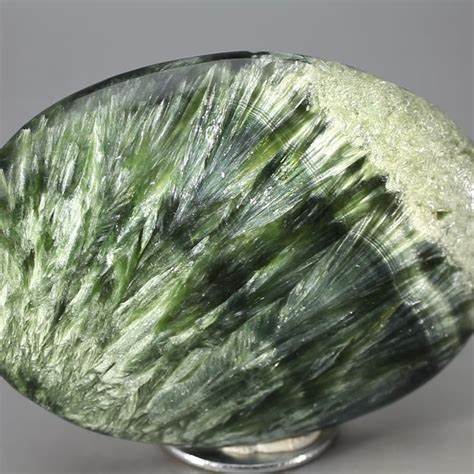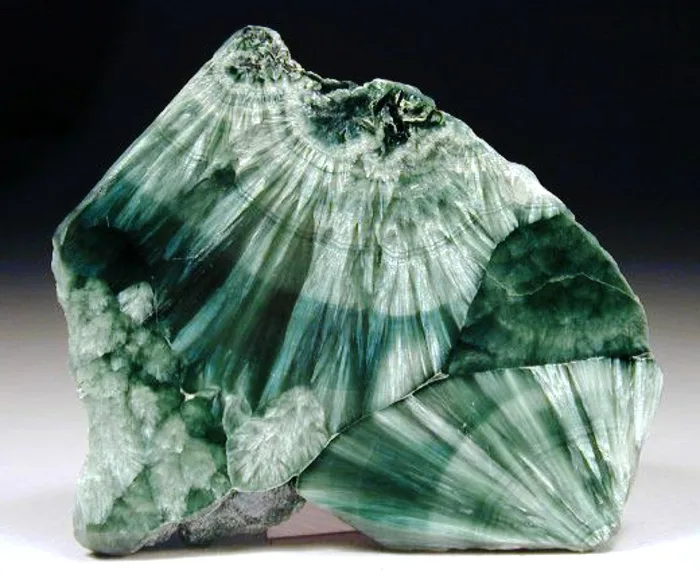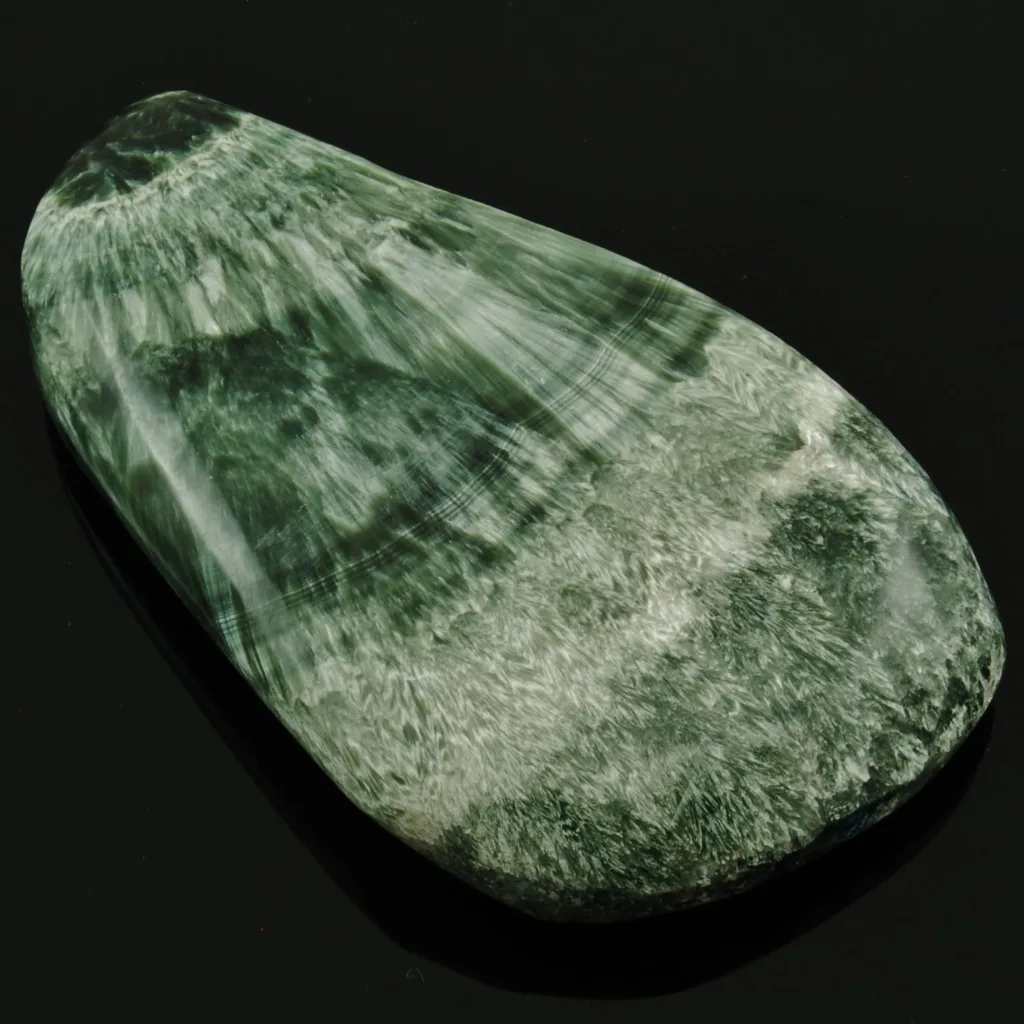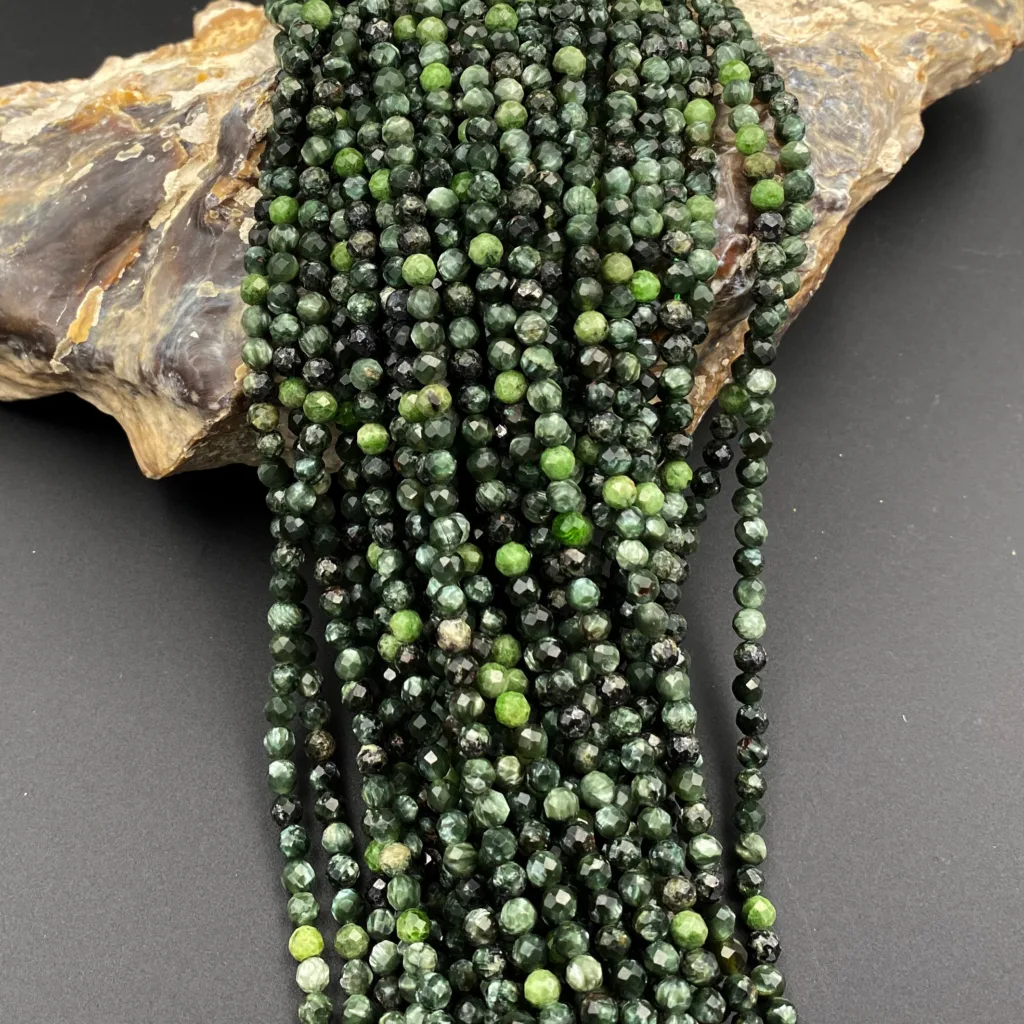Seraphinite is a unique and captivating gemstone known for its stunning green color, intricate patterns, and spiritual significance. It is a relatively rare variety of the mineral clinochlore, which belongs to the chlorite group. Seraphinite is admired not only for its aesthetic beauty but also for its purported metaphysical properties.


Seraphinite derives its name from the word “seraph,” which refers to a type of celestial being often depicted as a fiery angel in various religious traditions. This name is fitting due to the stone’s lustrous appearance and the patterns reminiscent of angelic wings that can be observed on its surface. Seraphinite is primarily valued as a decorative and ornamental gemstone, frequently used in jewelry pieces like pendants, necklaces, and cabochons.
Geological Formation and Composition:
Seraphinite forms as a result of the metamorphism of magnesium-rich rocks, usually occurring in regions with abundant chlorite and other minerals. It is commonly found in association with other minerals like quartz, feldspar, and talc. The green color of seraphinite is attributed to the presence of iron and other trace elements within its chemical composition.
What sets seraphinite apart is its distinctive feather-like or wing-like patterns that display an intriguing chatoyancy (cat’s eye effect) when polished. These patterns, referred to as “feathers” or “plumes,” resemble the intricate wings of angels and contribute to the stone’s captivating visual appeal.
Historical and Cultural Significance:
Seraphinite has not been deeply intertwined with historical or cultural significance to the same extent as some other gemstones. However, its aesthetic qualities and the resemblance of its patterns to angelic wings have led to spiritual and metaphysical associations.
In the world of metaphysical beliefs and alternative healing practices, seraphinite is often considered a stone of spiritual enlightenment and transformation. It is believed to promote self-healing, purification, and a connection to higher spiritual realms. Some individuals use seraphinite for meditation, believing that it can help facilitate communication with angels or spirit guides.
While seraphinite may not have a long history of cultural use or lore, its visual allure and the sense of connection to the ethereal have contributed to its popularity among those interested in crystals, energy work, and holistic well-being.
In summary, seraphinite is a captivating gemstone with a unique appearance reminiscent of angelic wings. Its geological formation involves metamorphism of magnesium-rich rocks, resulting in its distinct green color and feather-like patterns. While it may lack extensive historical or cultural significance, seraphinite has gained attention in spiritual and metaphysical circles for its potential to enhance spiritual experiences and healing practices.
Physical Characteristics of Seraphinite

Seraphinite is a distinctive gemstone with a range of physical characteristics that contribute to its unique beauty and appeal. Here are some of the key physical attributes of seraphinite:
- Color: Seraphinite is most commonly recognized for its rich green color. The green hue can vary from light to dark shades, often exhibiting a lush, deep green with undertones of silver or gray. The coloration is due to the presence of minerals such as iron within its composition.
- Lustre: The lustre of seraphinite is typically vitreous to pearly. When polished, the surface of the stone can display a natural sheen that adds to its overall attractiveness.
- Patterns and Inclusions: One of the most striking features of seraphinite is its intricate and feather-like patterns that resemble angel wings or plumes. These patterns, known as chatoyant or iridescent formations, create a captivating visual effect when the stone is moved under light. The patterns are caused by the orientation of mineral inclusions within the gem.
- Transparency: Seraphinite is typically opaque, meaning that light does not pass through the stone. The intricate patterns and chatoyancy are best appreciated when the stone is cut and polished as cabochons or beads.
- Hardness: Seraphinite falls within the range of 2.5 to 3 on the Mohs scale of mineral hardness. This places it on the softer side of the scale, which makes it more susceptible to scratching and damage compared to harder gemstones.
- Cleavage: Seraphinite has good cleavage in one direction, which means that it can be easily split or cleaved along certain planes. This characteristic affects the stone’s durability and how it can be cut and shaped.
- Density and Specific Gravity: Seraphinite has a relatively moderate density and specific gravity. These properties contribute to its overall weight and feel when held.
- Origin: The primary sources of seraphinite are found in the Lake Baikal region of Siberia, Russia. This area is known for producing some of the finest quality seraphinite with the most intricate and desirable patterns.
- Cut and Shape: Seraphinite is often cut into cabochons to highlight its chatoyant patterns. Cabochons are smoothly polished, convex-cut gemstones without facets. This cutting style allows the unique patterns to be showcased effectively.
In summary, seraphinite’s physical characteristics include its distinctive green color, chatoyant feather-like patterns, relatively low hardness, and association with the Lake Baikal region of Siberia. Its visual allure and unique appearance make it a sought-after gemstone for jewelry and decorative purposes, particularly among those who appreciate its spiritual and metaphysical qualities.
Mining and Sources of Seraphinite
Seraphinite is primarily sourced from the Lake Baikal region in Siberia, Russia. This area is renowned for producing some of the finest quality seraphinite specimens, known for their exceptional chatoyant patterns resembling angel wings or feathers. The specific mining and sourcing details for seraphinite are as follows:
1. Location: The Lake Baikal region is located in Siberia, Russia. This area is known for its stunning natural landscapes and abundant mineral resources.
2. Mining Process: Seraphinite is typically extracted through open-pit or underground mining methods. The mining process involves the following steps:
- Exploration: Geologists identify potential seraphinite deposits through geological surveys and mineralogical studies.
- Extraction: Miners use heavy machinery to extract seraphinite-bearing rocks from the earth.
- Processing: Once extracted, the raw material undergoes crushing, grinding, and sorting to separate seraphinite from other minerals.
- Cutting and Polishing: Seraphinite is then cut and polished into cabochons or beads to showcase its unique chatoyant patterns.
- Grading: Gemstone experts assess the quality of seraphinite based on factors such as color, clarity, patterns, and overall appearance.
3. Lake Baikal Region: The seraphinite deposits in the Lake Baikal region are associated with metamorphic rocks, particularly schists and gneisses. These rocks undergo geological processes that contribute to the formation of seraphinite, including the alteration of minerals like chlorite.
4. Characteristics of Russian Seraphinite: Seraphinite from the Lake Baikal region is often highly sought after due to its remarkable chatoyancy and intricate patterns. The feather-like formations and vibrant green color are distinctive features of Russian seraphinite. The unique patterns are caused by the orientation of fibrous mineral inclusions within the stone.
5. Availability and Rarity: Seraphinite is considered a relatively rare gemstone, and the most notable and prized specimens come from the Lake Baikal area. Its limited availability and distinct appearance contribute to its desirability among collectors, jewelry designers, and enthusiasts.
Due to its specific geological origins and the rarity of high-quality specimens, seraphinite from the Lake Baikal region is considered a treasured and valuable gemstone in the world of jewelry and mineral collecting. Its captivating patterns and connection to the natural beauty of Siberia make it a unique and sought-after choice for those who appreciate its aesthetic and metaphysical qualities.
Uses of Seraphinite

Seraphinite is a versatile gemstone that is prized for its unique appearance and potential metaphysical properties. Its distinctive green color, feather-like patterns, and spiritual significance have led to various uses, including both decorative and holistic purposes. Here are some of the common uses of seraphinite:
1. Jewelry: Seraphinite is frequently used in jewelry creation, particularly in pieces that emphasize its chatoyant patterns. Jewelry designers use seraphinite to create pendants, necklaces, rings, earrings, and bracelets. The stone’s captivating appearance makes it a popular choice for both casual and formal jewelry designs.
2. Cabochons and Beads: Seraphinite is often cut and polished into cabochons, which are smoothly rounded, non-faceted gemstones. These cabochons highlight the stone’s unique patterns and iridescence. Seraphinite beads are also popular for creating beaded jewelry.
3. Meditation and Energy Work: In the realm of metaphysics, seraphinite is believed to possess spiritual and energetic properties. Some individuals use seraphinite during meditation to enhance their spiritual experiences, promote self-awareness, and connect with higher realms. It is thought to help clear blockages and facilitate a sense of balance and harmony.
4. Healing and Wellness: Seraphinite is associated with healing and wellness in alternative and holistic practices. It is believed to have a purifying and detoxifying effect on the body, mind, and spirit. Some practitioners use seraphinite to aid in self-healing, emotional growth, and inner transformation.
5. Collecting and Display: Collectors of gemstones and minerals value seraphinite for its unique aesthetic and rarity. High-quality specimens with exceptional patterns are often sought after by mineral enthusiasts and collectors. Seraphinite can be displayed as part of a mineral collection or used as decorative pieces in homes and offices.
6. Spiritual and Metaphysical Decor: Some people incorporate seraphinite into their living spaces as a form of spiritual or metaphysical decor. Displaying seraphinite in a prominent place is believed to enhance the energy of the environment and promote a sense of tranquility and connection.
7. Gift Giving: Due to its beautiful appearance and potential spiritual significance, seraphinite is sometimes given as a thoughtful gift. It can be a meaningful present for individuals interested in crystals, meditation, and holistic well-being.
It’s important to note that the uses of seraphinite in metaphysical and holistic practices are based on belief systems and spiritual traditions. While many people find value and meaning in these uses, they are not scientifically proven effects of the gemstone.
Whether appreciated for its aesthetic appeal, believed metaphysical properties, or as part of a collection, seraphinite continues to captivate and inspire individuals across various contexts.
Recap of Key Points
- Seraphinite is a gemstone known for its distinctive green color, intricate feather-like patterns, and spiritual symbolism.
- It belongs to the chlorite group of minerals and is primarily composed of clinochlore.
- The name “seraphinite” is derived from “seraph,” referencing the stone’s angelic and luminous appearance.
- The gemstone is primarily sourced from the Lake Baikal region in Siberia, Russia, where it forms in association with metamorphic rocks.
- Seraphinite’s patterns, resembling angel wings, are caused by fibrous mineral inclusions that create a chatoyant effect.
- The Lake Baikal seraphinite is highly valued for its exceptional patterns and quality.
- Seraphinite has a hardness of 2.5 to 3 on the Mohs scale, making it relatively soft and susceptible to scratching.
- It is commonly cut into cabochons to showcase its chatoyant patterns and used in jewelry, including pendants, necklaces, and rings.
- Seraphinite is believed to have metaphysical properties, including promoting spiritual connection, self-healing, and purification.
- It is used for meditation, energy work, and holistic wellness practices.
- Seraphinite has been incorporated into spiritual decor, collections, and given as meaningful gifts.
- While its metaphysical effects are not scientifically proven, seraphinite continues to be admired for its beauty and perceived spiritual attributes.
Seraphinite’s unique appearance and potential significance make it a cherished gemstone among those interested in gemology, metaphysics, and personal adornment.




































